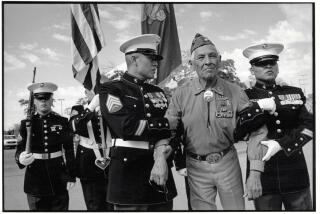R.C. Gorman; Native American Artist’s Portrayals of Navajo Women Were Highly Popular
- Share via
R.C. Gorman, a leading Native American artist whose archetypal portrayals of Navajo women in paintings, prints, ceramics and sculpture became enormously popular in homes and offices, died Thursday afternoon at University of New Mexico Hospital in Albuquerque. He was believed to be 73 or 74.
According to a statement posted on his website and signed by his agent, Virginia Dooley, Gorman had been ill for more than a month with a “virulent blood infection and pneumonia, among other issues.”
For the record:
12:00 a.m. Nov. 9, 2005 For The Record
Los Angeles Times Wednesday November 09, 2005 Home Edition Main News Part A Page 2 National Desk 1 inches; 34 words Type of Material: Correction
Gorman obituary -- The obituary of artist R.C. Gorman in Friday’s California section said Gorman had attended Northern Arizona University in Flagstaff. The school was called Arizona State College at Flagstaff when Gorman attended.
New Mexico Gov. Bill Richardson announced Gorman’s death at a news conference in Santa Fe and called him “a great citizen.”
Gorman was extremely popular in the 1970s and ‘80s, mass-producing prints, bronzes and ceramics that were snapped up by an eager public, including celebrities such as Jacqueline Kennedy Onassis, Elizabeth Taylor and Andy Warhol. As a Times story in 1985 said, his work became as “ubiquitous as Muzak.”
Though his art was often dismissed by critics as repetitive and uninspired, two of his paintings were selected for the 1973 exhibition “Masterworks of the Museum of the American Indian,” at the Metropolitan Museum of Art in New York City.
He was the only living Native American artist included, and one of his pieces was used for the cover of the exhibition catalog.
Rudolph Carl Gorman was born in Chinle, Ariz., on the Navajo Reservation in either July 1931 or July 1932 (he was uncertain of the date). His father, C.N. Gorman, was a noted artist and teacher. As a boy, he lived in the traditional Navajo hogan and herded sheep. He began drawing at the age of 3.
“I was raised on the reservation, and we didn’t have very much,” Gorman once told The Times. “The only thing I had to go on were books on artists, and I went through the whole gamut. My favorites were artists like Rembrandt and Michelangelo and Van Gogh. Up to Picasso.”
He would later credit a teacher, Jenny Lind of the Ganado Presbyterian Mission School in Arizona, for starting him as a practicing artist.
“She gave me lessons in art history and different mediums and always encouraged me,” he told Associated Press. “I guess she was the most influential teacher that I ever had.”
After high school, he served in the Navy before attending Northern Arizona University in Flagstaff, where he majored in literature and minored in art. He later studied art at Mexico City College on scholarship from the Navajo Tribal Council before moving to San Francisco, where he worked on his art and supported himself as a model.
He would later call his experience in Mexico transforming.
“What really changed a lot of my ways of expressing myself was when I went to Mexico and saw those very bold impressions from the Mexican artists like Siqueiros and Tamayo,” he told The Times.
A series of small shows in the San Francisco area in the late 1950s and early 1960s brought him some initial success. In the mid-’60s, he moved to Taos, N.M., and bought a gallery, which he renamed the Navajo Gallery. It was his base until his death.
He produced works using acrylics, oils and oil pastels and also turned to lithographs.
In many of his works, the focal point is a subject often engaged in simple activities. In his view, contextual background wasn’t necessary, but only the person’s physical presence and spiritual bearing. His images often depicted the face, hands and feet of the subject in great detail.
By the 1980s, Gorman was increasingly working in bronze sculpture, ceramics and even etched glass.
Over the years, he developed a highly commercial formula for his success. He would appear at as many as 10 shows a year; many sold out. His lithographs now sell for $1,300 to $5,000, his bronze sculptures for $25,000 to $30,000, and his pastels for about $15,000.
He seemed to care little about his place in art history, once telling The Times that enduring fame “is not a big, important thing to me.”
Gorman published several books, including “Nudes and Food: Gorman Goes Gourmet” and “R.C. Gorman’s Nudes and Foods in Good Taste.”
Information on survivors was not immediately available.
Services are pending.
More to Read
The biggest entertainment stories
Get our big stories about Hollywood, film, television, music, arts, culture and more right in your inbox as soon as they publish.
You may occasionally receive promotional content from the Los Angeles Times.










